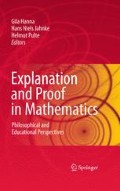Abstract
Lakoff and Núñez have argued that all of mathematics is a conceptual system created through metaphors on the basis of the ideas and modes of reasoning grounded in the sensory motor system. This paper explores this view by means of a Lakatosian reconstruction of the history and prehistory of the intermediate-value theorem, in which the notion of continuity plays an essential role. I conclude that in order to give an acceptable description of the actual development of mathematics, Lakoff’s and Núñez’s view must be amended: Mathematics can be viewed as a system of conceptual metaphors; however, it is permanently refined through proofs and refutations.
Parts of this paper are based on Koetsier (1995).
Access this chapter
Tax calculation will be finalised at checkout
Purchases are for personal use only
Notes
- 1.
Quoted in Lakatos (1961/1973, p. 73).
- 2.
Spalt (1988) also deals with the history of the intermediate value theorem.
- 3.
Cf. Müller and Kronert (1969, p. 136).
- 4.
Leibniz (1695, p. 284).
- 5.
Leibniz (1695, p. 284).
- 6.
Leibniz wrote Y, Z and Y+Z, in this sentence, but must have meant Y, Z and Y+Z.
- 7.
Leibniz (1695, pp. 284-285)
- 8.
Lagrange (1808, pp. 1–2)
- 9.
Lagrange (1808, pp. 101–102)
- 10.
In the following reconstruction I will interpret some of Cauchy’s results in accordance with the traditional view of his work. A good presentation of this view is in Grabiner (1981). Grabiner nicely shows that the idea that the notion of limit is related to methods of approximation played an important heuristic role in Cauchy’s foundational work. For a rather different view of Cauchy’s foundational work in analysis see Spalt (1996).
- 11.
I am not the first one to suggest that Cauchy’s definition of continuity was born here. Cf. Daval and Guilbaud (1945, p. 117).
- 12.
Cauchy (1821, pp. 115–116)
References
Allis, V., & Koetsier, T. (1991). On some paradoxes of the Infinite. British Journal Philosophy of Science, 42(1991): 187–194.
Allis, V., & Koetsier, T. (1995). On some Paradoxes of the Infinite II. British Journal Philosophy of Science, 46(1995): 235–247.
Koetsier, T., & Allis, V. (1997). Assaying Supertasks. Logique & Analyse, 40(1997): 291–313.
Black, M. (1962). Models and Metaphors. Ithaca: Cornell University Press.
Bolzano, B. (1817). Rein analytischer Beweis des Lehrsatzes, daß zwischen je zwey Werthen, die ein entgegengesetztes Resultat gewähren, wenigstens eine reelle Wurzel der Gleichung liege. Gottlieb Haase, Prag (Reprint in Czechoslovak Studies in the History of Science 12 (1981). ‘Bernard Bolzano, Early Mathematical Works’. Special Issue: 417–476).
Cauchy, A. (1821). Cours d’analyse, Paris, Oeuvres, second series, Vol. 3.
Clairaut. (1797). Élémens d’Algèbre par Clairaut, 5ième édition, Tome Second, Paris An. V.
Daval, R., & Guilbaud, G.-T. (1945). Le raisonnement mathématique. Paris: Presses universitaires de France.
Dedekind, R. (1927). Stetigkeit und irrationale Zahlen, 5. Auflage, Braunschweig.
De Swart, H. C. M., & Bergmans, L. J. M. (eds.) (1995). Perspectives on Negation, Essays in honour of Johan J. de Iongh on his 80th birthday. Tilburg: Tilburg University Press.
Encontre, D. (1813/1814). Mémoire sur les principes fondamentaux de la théorie générale des équations. Annales de Mathématiques Pures et Appliquées Tome IV: 201–222. Available digitally: http://archive.numdam.org.
Euler, L. (1748). Introductio in analysin infinitorum (Vol. I). Lausanne (Euler’s Opera Omnia, Series I, Vol. 8).
Euler, L. (1751). Recherches sur les racines imaginaires des équations. Opera Omnia, Series I, 6: 78–147.
Grabiner, J. V. (1981). The origins of Cauchy’s rigorous calculus. Cambridge, London: MIT Press.
Heath, T. (1956). The thirteen books of the elements, 2nd ed. New York: Dover Publications.
Heine, E. (1872). Die Elemente der Functionenlehre. Journal für die reine und angewandte Mathematik Band 74: 172–188.
Klügel, G. S. (1805). Mathematisches Wörterbuch, Band II, Leipzig.
Koetsier, T. (1991). Lakatos’ Philosophy of Mathematics. Amsterdam: Elsevier.
Koetsier, T. (1995). Negation in the development of mathematics: Plato, Lakatos, Mannoury and the history of the intermediate-value theorem in analysis. In H. C. M. De Swart & L. Bergmans (eds.): 105–121.
Lagrange, J. L. (1808). Traité de la résolution des équations numériques de tous les degrés. Paris: Courcier.
Lakatos, I. (1976). Proofs and Refutations, The Logic of Mathematical Discovery. Ed. by J. Worrall & E. Zahar. Cambridge: Cambridge University Press.
Lakatos, I. (1961/1973). The method of analysis-synthesis. In Lakatos (1978). Mathematics, Science and Epistemology: Philosophical Papers Volume 2. Cambridge University Press, Cambridge 1978: 70–103.
Lakoff, G., & Núñez, R. E. (2000). Where mathematics comes from, How the embodied mind brings mathematics into being. New York: Basic Books.
Leibniz, G. W. (1695). Specimen geometriae luciferae. In C. I. Gerhardt (Hrsg.) Mathematische Schriften, Band 7, New York, 1971 (reprint of 1863 edition).
Müller, K., & Kronert, G. (1969). Leben und Werk von Leibniz. Eine Cronologie. Frankfurt.
Spalt, D. D. (1988). Das Unwahre des Resultatismus, Eine historische Fallstudie aus der Analysis. Mathematische Semesterberichte, 35(1988): 6–36.
Spalt, D. D. (1996). Die Vernunft im Cauchy-Mythos. Frankfurt/M: Deutsch.
Way, E. C. (1991). Knowledge representation and metaphor. Dordrecht: Kluwer.
Acknowledgements
I am grateful to Brendan Larvor and to two anonymous referees for commenting on an earlier version of this paper.
Author information
Authors and Affiliations
Corresponding author
Editor information
Editors and Affiliations
Rights and permissions
Copyright information
© 2010 Springer Science+Business Media, LLC
About this chapter
Cite this chapter
Koetsier, T. (2010). Lakatos, Lakoff and Núñez: Towards a Satisfactory Definition of Continuity. In: Hanna, G., Jahnke, H., Pulte, H. (eds) Explanation and Proof in Mathematics. Springer, Boston, MA. https://doi.org/10.1007/978-1-4419-0576-5_3
Download citation
DOI: https://doi.org/10.1007/978-1-4419-0576-5_3
Published:
Publisher Name: Springer, Boston, MA
Print ISBN: 978-1-4419-0575-8
Online ISBN: 978-1-4419-0576-5
eBook Packages: Humanities, Social Sciences and LawEducation (R0)

